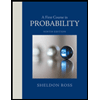
A First Course in Probability (10th Edition)
10th Edition
ISBN: 9780134753119
Author: Sheldon Ross
Publisher: PEARSON
expand_more
expand_more
format_list_bulleted
Question
![4. Let 1A be the indicator of event A. That is, the random variable 1A takes the
value 1 if A occurs and is 0 if AC occurs.
(a) What is the support of 1A?
(b) What is the p.m.f. of 1A?
(c) Compute E[1A].
(d) What should the subscript of the indicator r.v. on the r.h.s. of the fol-
lowing equation be so that equality holds?
1A +1B-1AB = 1?.
You may assume that A and B are events.
(e) Take the expected value of each side, and you end up with what familiar
equation?](https://content.bartleby.com/qna-images/question/b0db66b4-6d7a-46e4-9c57-98cfdf821e07/3490fa8e-f25a-448c-adcd-1fabe3700dd7/nm3lb0m_thumbnail.jpeg)
Transcribed Image Text:4. Let 1A be the indicator of event A. That is, the random variable 1A takes the
value 1 if A occurs and is 0 if AC occurs.
(a) What is the support of 1A?
(b) What is the p.m.f. of 1A?
(c) Compute E[1A].
(d) What should the subscript of the indicator r.v. on the r.h.s. of the fol-
lowing equation be so that equality holds?
1A +1B-1AB = 1?.
You may assume that A and B are events.
(e) Take the expected value of each side, and you end up with what familiar
equation?
Expert Solution
This question has been solved!
Explore an expertly crafted, step-by-step solution for a thorough understanding of key concepts.
Step by stepSolved in 2 steps with 1 images

Knowledge Booster
Similar questions
- Suppose X is a random variable with E(X) = 0 and Var(X) = 2. What is E(X2 )? a). 1 b). 2 c). 3 d). 4 e). none of abovearrow_forward1. The random variables §, §1, §2,... are independent and identically distributed with 1/4 and P(§ = j) = c/j for j = 1,2,3. Let X₁ = 0 and Xn = max(§₁, ..., Èn) for n = 1, 2,.... distribution P(§ = 0) = (a) What value must c take? (b) Explain why {Xn, n = 0, 1, 2,...} is a Markov chain. (c) Write down the transition matrix. (d) Draw the transition diagram and classify the states (aperiodic, transient, re- current, eorgodic, etc). (e) Calculate P(Xn = 0). (f) Calculate P(X₁ = 3, X₂ = 1|X₁ = 3).arrow_forward8) Consider the following Random Variable X X = k Pr(X=k) 3 .2 7 .1 1 .4 .2 .1 Find the following: a) Pr(X > 4) b) E(X) c) V(X)arrow_forward
arrow_back_ios
arrow_forward_ios
Recommended textbooks for you
 A First Course in Probability (10th Edition)ProbabilityISBN:9780134753119Author:Sheldon RossPublisher:PEARSON
A First Course in Probability (10th Edition)ProbabilityISBN:9780134753119Author:Sheldon RossPublisher:PEARSON

A First Course in Probability (10th Edition)
Probability
ISBN:9780134753119
Author:Sheldon Ross
Publisher:PEARSON
